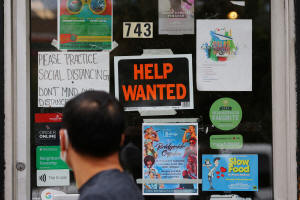U.S. labor market defies recession fears as job growth surges in July
 Send a link to a friend
Send a link to a friend
 [August 06, 2022] By
Lucia Mutikani [August 06, 2022] By
Lucia Mutikani
WASHINGTON (Reuters) - U.S. job growth
unexpectedly accelerated in July, lifting the level of employment above
its pre-pandemic level and pouring cold water on fears the economy was
in recession.
The Labor Department's closely watched employment report on Friday also
showed employers continuing to raise wages at a strong clip and
generally maintaining longer hours for workers. The sustained labor
market strength could give the Federal Reserve the latitude to keep
aggressively hiking interest rates.
"If the U.S. economy is in a recession, no one seems to have told
employers," said Sarah House, a senior economist at Wells Fargo in
Charlotte, North Carolina. "We suspect this data will give the Fed the
confidence it needs to push ahead aggressively with its fight against
inflation."
Nonfarm payrolls increased by 528,000 jobs last month, the largest gain
since February, the survey of establishments showed. Data for June was
revised higher to show 398,000 jobs created instead of the previously
reported 372,000. July marked the 19th straight month of payrolls
expansion, and blew off economists' expectations for a gain of only
250,000 jobs.

Estimates in the Reuters survey for the number of jobs gained ranged
from a low of 75,000 to a high of 325,000.
The labor market has now recouped all the jobs lost during the COVID-19
pandemic, though government employment remains about 597,000 jobs in the
hole. Overall employment is now 32,000 jobs higher than in February
2020.
It took just under 2-1/2 years to recover all the jobs compared to at
least six years after the 2007-2009 Great Recession.
The Fed last week raised its policy rate by three-quarters of a
percentage point and officials have pledged more hikes are coming as the
U.S. central bank tries to rein in inflation. Annual consumer prices are
rising at their fastest pace in four decades. Since March, the Fed has
lifted its benchmark overnight interest rate from near zero to a range
of 2.25% to 2.50%.
"The Fed is looking increasingly likely to be able to maintain its
current trajectory without constantly looking over its shoulder, making
it the envy of world economies who are all enduring the same knife-edge
balancing act at the moment," said James Bentley, a company director at
Financial Markets Online.
U.S. gross domestic product declined in the first and second quarters,
meeting the standard definition of a recession. The economy's 1.3%
contraction in the first half of the year was mostly because of big
swings in inventories and the trade deficit tied to snarled global
supply chains.
The National Bureau of Economic Research, the official arbiter of
recessions in the United States, defines a recession as "a significant
decline in economic activity spread across the economy, lasting more
than a few months, normally visible in production, employment, real
income, and other indicators."
But even with July's robust jobs gains, some cracks are forming in the
labor market. Businesses in the interest-rate-sensitive housing,
finance, technology and retail sectors are laying off workers. Still,
with 10.7 million job openings at the end of June and 1.8 openings for
every unemployed person, a sharp deceleration in payrolls growth is
unlikely this year.

[to top of second column] |

A pedestrian passes a "Help Wanted" sign in the door of a hardware
store in Cambridge, Massachusetts, U.S., July 8, 2022. REUTERS/Brian
Snyder/

Stocks on Wall Street were trading lower. The dollar rallied against a basket of
currencies. U.S. Treasury prices fell.
WIDESPREAD GAINS
The broad job gains last month were led by the leisure and hospitality industry,
which added 96,000 positions, most of them at restaurants and bars. But leisure
and hospitality employment remains down by 1.2 million from its February 2020
level.
Professional and business services payrolls increased by 89,000, while the
healthcare sector added 70,000 jobs. Government employment jumped by 57,000
jobs, boosted by local government education. Construction added 32,000 jobs
while manufacturing payrolls increased by 30,000.
Details of the household survey from which the unemployment rate is derived were
mixed. While the unemployment rate fell to its pre-pandemic low of 3.5% from
3.6% in June, that was because 63,000 people left the labor force. The workforce
has now declined for two straight months.
The labor force participation rate, or the proportion of working-age Americans
who have a job or are looking for one, edged down to 62.1% from 62.2% in June.
That mostly reflected a drop in participation by teenagers.
The prime-age population's participation rate ticked up to 82.4% from 82.3% in
June. The employment-population ratio for this cohort rebounded to 80%,
consistent with full employment.
The number of people working part-time for economic reasons increased by 303,000
to 3.9 million after plunging to more than a 20-year low in June.

But household employment rebounded by 179,000 jobs after falling 315,000 in
June, and the number of people experiencing long spells of unemployment dropped
269,000 to 1.1 million, the lowest level since April 2020. These long-term
unemployed accounted for 18.9% of the 5.7 million unemployed in July.
With the labor market tightening further, average hourly earnings increased 0.5%
after rising 0.4% in June. That left the year-on-year increase in wages at 5.2%.
The workweek was unchanged at 34.6 hours.
Wage gains were mostly driven by industries in the services sector, including
leisure and hospitality, financial, and professional and business services. A
proxy for take-home pay surged 1.2% on a month-on-month basis, which bodes well
for consumer spending amid declining gasoline prices.
"The risk to wage growth appears to be on the upside in the near term given the
persistent strength of the labor market and the lack of a rebound in the labor
supply," said Lydia Boussour, lead U.S. economist at Oxford Economics in New
York.
(Reporting by Lucia Mutikani; Editing by Chizu Nomiyama and Paul Simao)
[© 2022 Thomson Reuters. All rights
reserved.]This material may not be published,
broadcast, rewritten or redistributed.
Thompson Reuters is solely responsible for this content. |